Pad thai may have all the fame, but Thai food lovers know that pad see ew is where real noodle bliss is at. With almost 2 million views on YouTube, this pad see ew recipe is tried and true, and I promise it'll rival anything you've had at Thai restaurants! It's a quick and simple dish, but you need to know some tricks to achieve perfectly seasoned, not-broken rice noodles with that smokey wok char. Let's dive in!
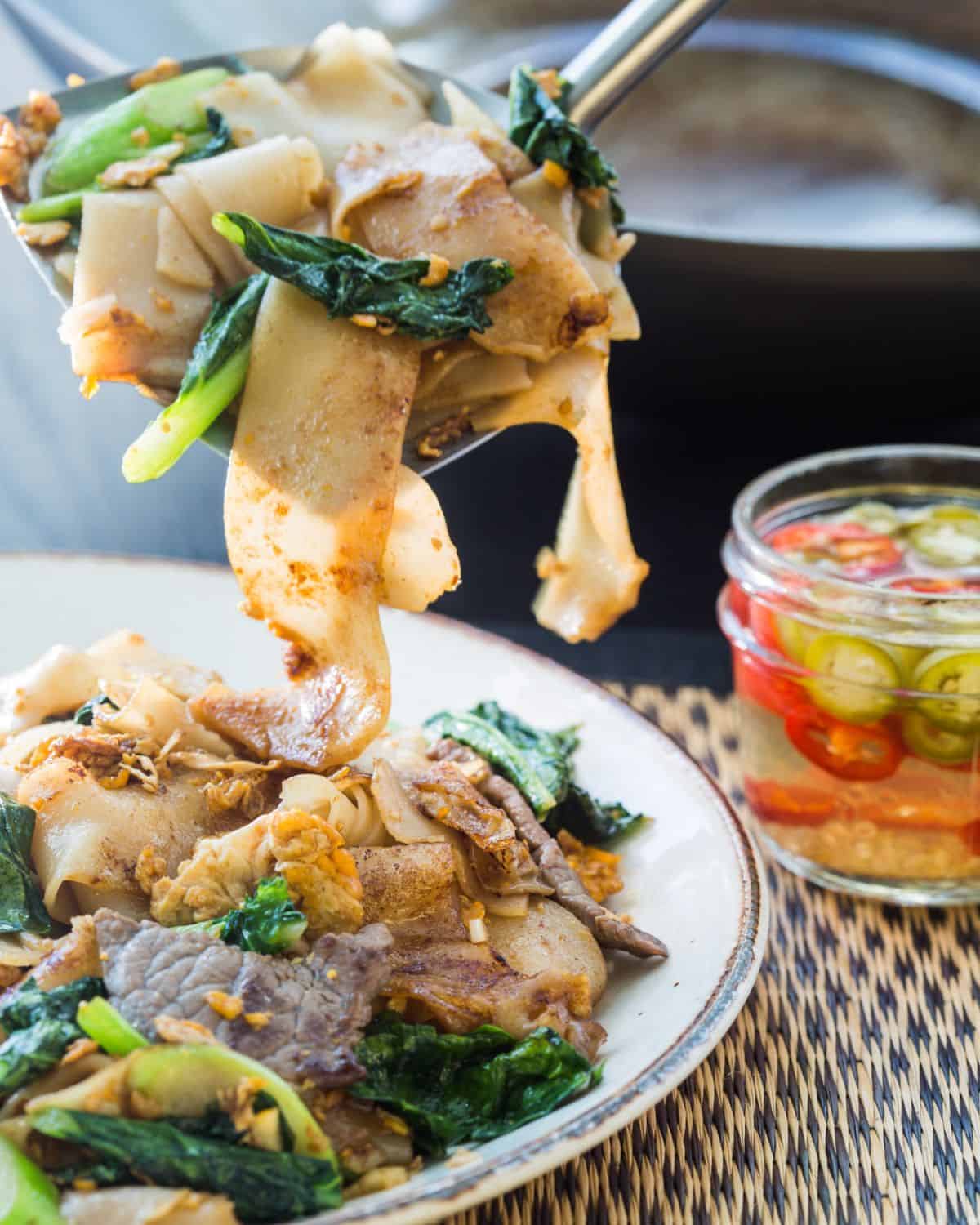
Watch The Video Tutorial
All my recipes come with video tutorial to ensure success. If you've never made pad see ew before, I highly recommend watching the video first as this dish goes fast, and you'll need to know exactly what to do once the heat is on!
Jump to:
What is Pad See Ew?
In Thai, pad means to stir fry and see ew means soy sauce, so...soy sauce stir fry? The unspoken word is guay tiew or "noodles," so it's full name is guay tiew pad see ew. It's a popular Thai stir-fried noodles that you can find all over Thailand, but it has its roots in Chinese cuisine which came to Thailand with the millions of Chinese immigrants.
It's a homey dish of fresh rice noodles seasoned primarily with soy sauce, and stir fried in a hot wok along with slices of meat and Chinese broccoli. In Thailand, pad see ew is a quick solo lunch, so you often find it sold at food courts and by street vendors. They're kind of like the sandwiches of Thai cuisine!
Ingredients
Pad see ew ingredients are short and simple, but using the right noodles and the right sauces are key.
- Fresh wide rice noodles. These tender rice noodles with a slight chew are what make dishes like pad see ew and drunken noodles (pad kee mao) so lovable. These are called sen yai in Thai, but here they are commonly called ho fun noodles (Cantonese). You can buy these at many Asian grocery stores in the refrigerated section, usually close to the tofu. If you can't find them, you can also make your own. Dried wide rice noodles also exist and can be used if necessary, but they are quite different and not as good as the fresh ones.
- Protein of your choice, thinly sliced. This can be chicken, pork, beef, tofu, or seafood such as shrimp. In Thailand, pork is the most common.
- Soy sauce for marinating the meat, omit if using shrimp or tofu which do not need to be marinated.
- Vegetable oil or another neutral oil of your choice
- Garlic, chopped
- Eggs
- Chinese broccoli, also known as gai lan. Choose smaller stalks if you can as they are more tender and are less likely to be bitter. If you cannot find gai lan, broccolini is a good substitute, or even broccoli. I don't suggest using bok choy as it is much more watery and lacks the crunchiness of gai lan stems.
- Sugar. White sugar is fine, but brown sugar will also work.
- Ground white pepper, to taste
- Prik nam som, Thai-style chili vinegar that is a classic condiment that I highly recommend. Pad see ew is sweet and salty, and drizzling a little spicy vinegar really brightens the dish and makes a more balanced flavour. It is made simply by adding some sliced hot peppers of your choice to some white vinegar. Jalapenos, serranos or Thai chilies are all great options.
Pad See Ew Sauce
A good sauce it key to great pad see ew flavour, so I suggest measuring ingredients properly and not eyeballing this one! Here's a video where I go through all the different sauces used in Thai cuisine.
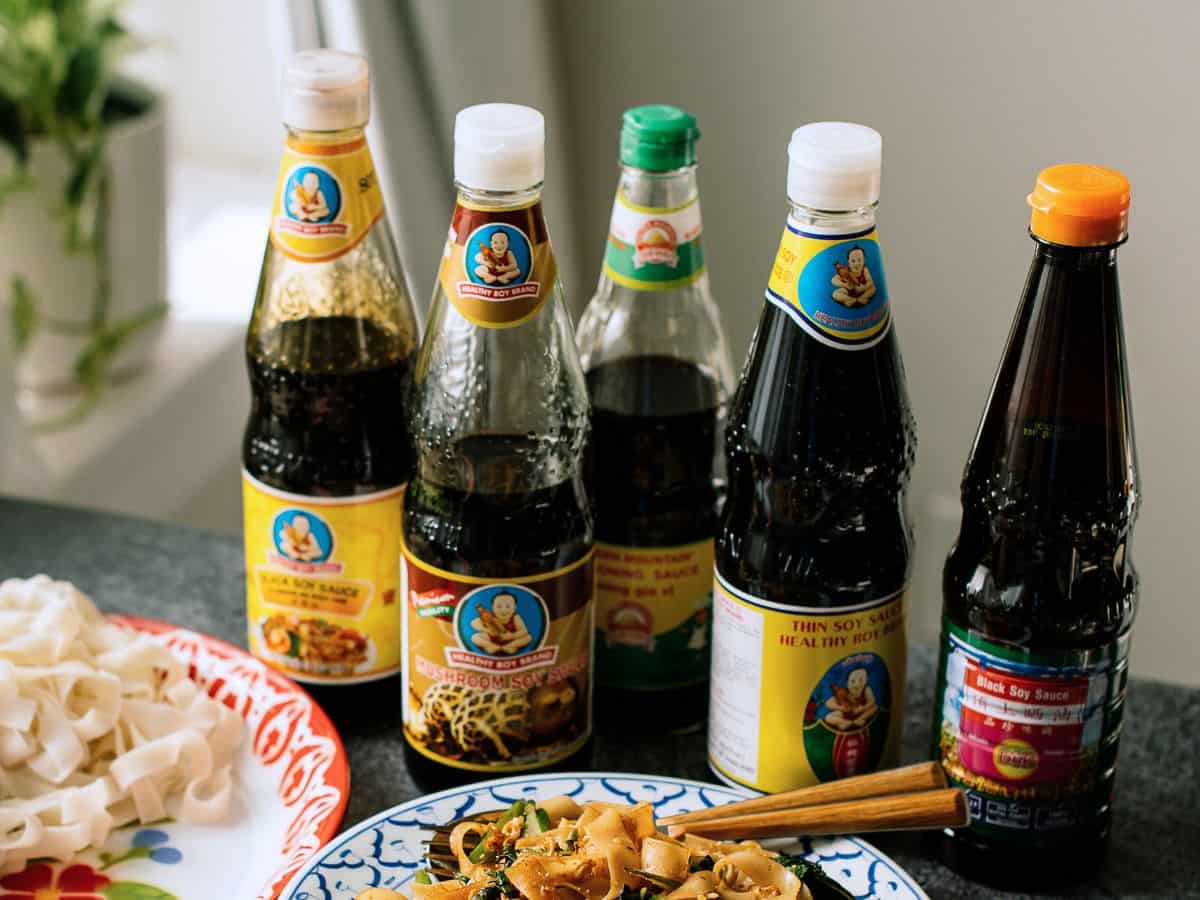
- Oyster sauce. Check out my post for how to choose a good oyster sauce.
- Soy sauce. Use Thai soy sauce if you can for the right flavour, but otherwise regular soy sauce such as kikkoman, or Chinese light soy sauce will also do.
- Fish sauce. See this post on choosing a good fish sauce.
- Golden Mountain Sauce. This is a type of Thai soy sauce with a flavour that is slightly richer than the Thai soy sauce. Maggi Seasoning would be a fine substitute, but you can also substitute an equal amount of soy sauce.
- Thai black soy sauce or Chinese dark soy sauce. This gives pad see ew its characteristic dark brown colour. Black soy sauce isn't very salty, but it is used in small amounts to give a dark colour and slightly richer flavour.
How to Make Pad See Ew
If it's your first time, I highly recommend watching the video tutorial to ensure success. The cooking goes fast, so it's good to know exactly what you need to do before you turn the heat on.
Most important tip: Cook 1 portion of noodles at a time for maximum noodle char and prevent mushy, broken noodles. There's a reason street vendors do it this way! (All of the meat can be cooked in one batch.)
- Stir the meat and soy sauce together well, then add a little bit of oil and stir to coat the meat. The oil will help the meat separate from each other more easily when you go to cook it.
- Combine all sauce ingredients together and stir to mix.
- Heat the oil in a well-seasoned wok or a large non-stick skillet over high heat. When hot, add all of the protein and toss just until the meat is done. Remove from pan and set aside. If there is meat juices left in the wok, wipe it with a paper towel.
- From this step onward, I recommend cooking 1 portion at a time for best results. Add vegetable oil and garlic to the wok and sauté over medium high heat until the smallest bits of garlic starts to turn golden.
- Add the egg and scramble briefly.
- Add the Chinese broccoli and toss to coat it evenly in the oil, about 10–15 seconds.
- Add 1 portion of the rice noodles (8oz/225g), 2 tablespoon + 1 teaspoon (35 ml) of the sauce mixture, and 2 teaspoon (10 ml) of sugar. Turn the heat up to high and toss to coat the noodles evenly in the sauce.
- Spread the noodles out and let them sit without stirring for about 15-30 seconds until some of the noodles have charred. Flip the noodles and let them sit again to char the other side. You may flip the noodles again a couple more times to get more toasting if you wish.
- Add 1 portion of the cooked protein back in, being careful not to add any meat juices that has accumulated in the bowl, and toss briefly to mix.
- Plate the noodles, then quickly wipe the pan clean with paper towel and cook the next serving.
Common Problems and How to Avoid Them
After many years of teaching this recipe, I've noticed there are a few things that commonly trip people up. Read these carefully to avoid the same problem!
- Broken noodles. You're likely stirring too aggressively. Fresh noodles are delicate, so you want to flip and toss rather than stir when possible.
- Mushy noodles. You might be crowding the pan and trapping too much moisture, which overcooks the noodles. In the recipe I stress that you should cook one portion at a time, this is so that you have ample space to create charring on the noodles, but it also prevents trapping too much moisture under a pile of noodles. Remember these noodles are already fully cooked, so it doesn't take much additional moisture for them to become over cooked and mushy! You can get away with 2 portions if you have a large wok and a high BTU stove.
- They don't taste right. Did you eyeball ingredients? Did you measure everything? Pad see ew is one of those dishes where the ratio between sauce and noodles is everything. So if you put too much noodles, they're going to taste bland. If you put too little, it's going to be overly salty.
- Noodles stuck to the pan. Fresh rice noodles love to stick. Make sure your wok is well seasoned or use a nonstick pan.
- There is no wok hei. Wok hei is that smoky wok flavour that many people consider a key ingredient of a good pad see ew. To get wok hei, you need a carbon steel wok on very high heat so the noodles can char and the oil can smoke. Not crowding the pan is also key. Sometimes, this just isn't possible to create given our home equipment, but I think it's still good without it!
How to Use Dry Rice Noodles Instead
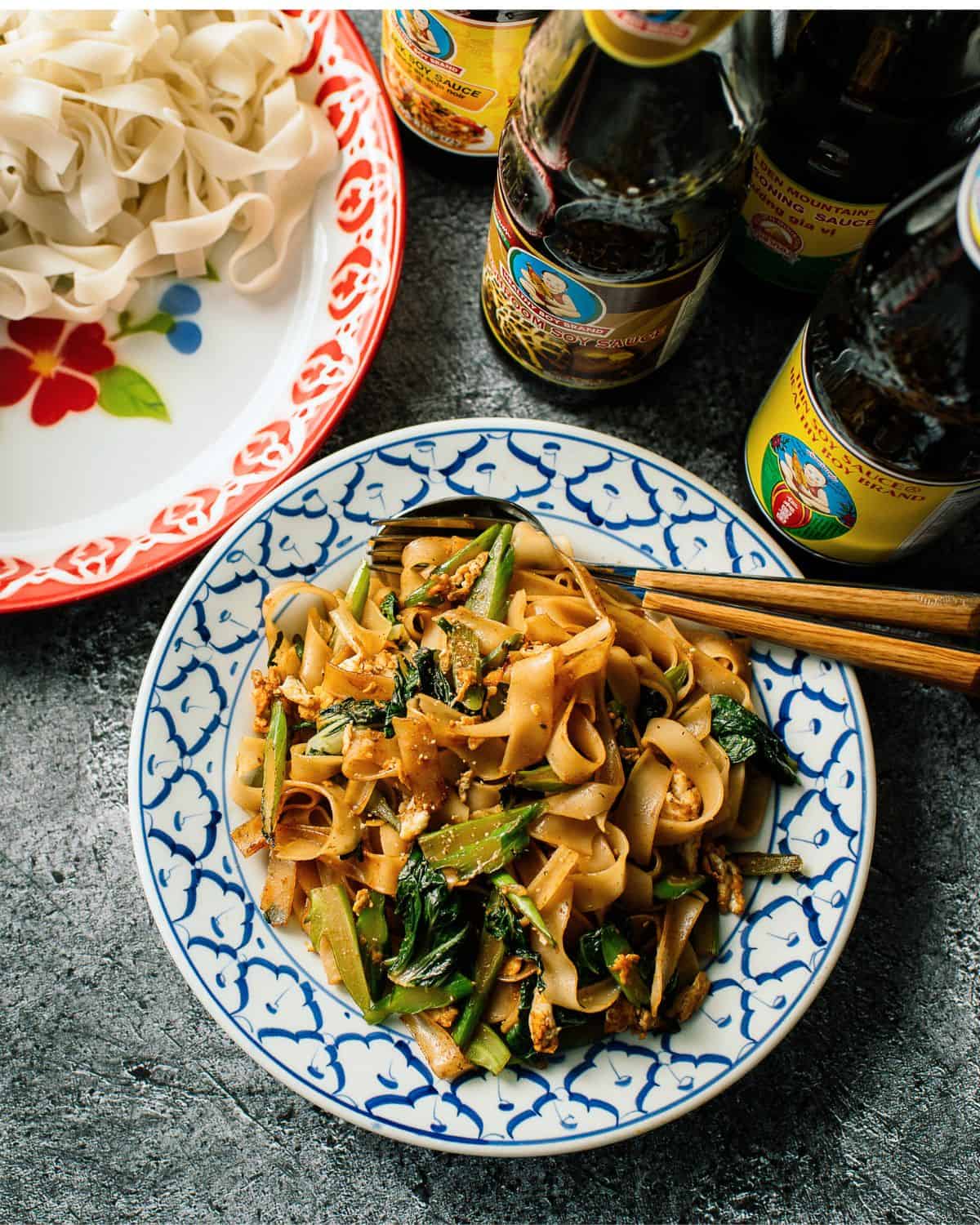
If you don't have access to fresh rice noodles, it is possible to use the dried version. However, cooked dried rice noodles do not have the same texture as fresh, in the same way that cooked dried pasta is very different from fresh pasta. I much prefer fresh, but I'll happily eat the dried version if that's all there is.
Don't follow package instructions for cooking the noodles, those can be unreliable. Here's what o do:
Soak the noodles in hot off the boil water for 15 minutes, then drain and rinse under cold water. The noodles are now partially cooked and ready to go into the wok, and they will finish cooking in the wok.
When cooking, I suggest tasting the noodles when you think they're done, and if they're still a little too firm, add a splash of water and keep cooking for another minute.
Frequently Asked Questions
Yes! In Thailand we actually make pad see ew with a few different noodles. The other common one is made with rice vermicelli, so check out my vermicelli pad see ew recipe. In Southern Thailand I grew up eating pad see ew with egg noodles.
Some have asked if pad thai noodles can be used instead, and while it is not done in Thailand, you can certainly try. Follow the soaking instructions in my pad thai recipe, and you'll need to add about 2 tablespoon of water per portion when cooking.
Yes. I would recommend chicken thighs, cut into bite-sized pieces, but chicken breast will also work if that's what you prefer.
You can use tofu instead of meat. Use firm or extra firm tofu and fry them first until golden to firm up the surface. Then add them to the noodles at the end. You can use vegetarian oyster sauce instead of oyster sauce (read more about vegetarian oyster sauce here) and substitute soy sauce for the fish sauce.
Pad see ew, like all rice noodle dishes, does not keep well. So the best thing to do is to not make anymore than you can eat today. Reheated rice noodles never have quite the same texture.
However, if you must, store it in an airtight container and reheat in the microwave until the noodles are piping hot. Rice noodles turn hard when cold and will not regain their soft texture unless they're thoroughly heated.
I recommend keeping it for no longer than one day.
More Thai Stir-Fried Noodle Recipes
Once you've mastered pad see ew, here are a few other Thai recipes to satisfy your noodle cravings:
- Pad kee mao or "drunken noodles". If you love pad see ew and you love spicy, this is a must try. You can think of this as the spicy sister of pad see ew, or a noodle version of pad gaprao.
- Rad na sometimes spelled as lad na, this is one of the most underrated Thai noodle dishes! The same fresh wide rice noodles are charred in a wok, and served with a pork gravy over them.
- Pad See Ew with Vermicelli. If wide noodles are not available, try going the other extreme and make PSE with the thinnest of noodles! It's also a very quick and easy dish!
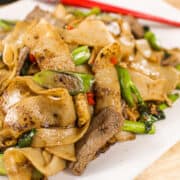
Pad See Ew ผัดซีอิ้ว
- Prep Time: 20 min
- Cook Time: 10 min
- Total Time: 30 minutes
- Yield: 2 servings
Description
Chewy-tender fresh wide rice noodles are stir fried with a savory sauce and crunchy Chinese broccoli. There's a reason pad see ew is a cult favorite, and a personal favourite street food dish of mine!
Ingredients
Note: I recommend making 1 serving at a time to maximize noodle toasting, so you may want to split the ingredients in half when doing your prep. All the protein, however, can be cooked all together.
- 170g (6oz) protein of your choice, thinly sliced (see note 1)
- 1 Tbsp (15 ml) soy sauce for marinating meat, omit if using shrimp or tofu
- 3-4 tablespoon (45-60 ml)vegetable oil
- 4 cloves garlic, chopped
- 2 eggs
- 4-6 stalks (150 g) Chinese broccoli, aka gai lan, stems thinly sliced on a bias, leaves roughly chopped
- 1 lb (450g) fresh wide rice noodles (ho fun noodles), store bought or make your own (see note 2)
- 4 tsp granulated sugar
- Ground white pepper, to taste
- Optional condiment: Prik nam som or chili vinegar (see note 3)
Sauce
- 2 Tbsp (30 ml) oyster sauce
- 1 Tbsp (15 ml) soy sauce
- 1 ½ tsp (7.5 ml) fish sauce
- 1 ½ tsp (7.5 ml) Golden Mountain sauce, or sub Maggi Seasoning or soy sauce
- 2 tsp (10 ml) Thai black soy sauce or dark soy sauce
For descriptions of all these sauces, see this video
Instructions
- Mix together the meat and 1 tablespoon (15 ml) of soy sauce, then add about 2 teaspoon (10 ml) of oil and stir to coat the meat; the oil will help the meat separate more easily in the pan.
- Separate the noodles into individual portion - 8 oz (225 g) per portion.
- Combine all sauce ingredients together and stir to mix well, divide the sauce evenly into individual portions - each portion is 2 tablespoon + 1 teaspoon (35 ml)
- Heat 1 tablespoon (15 ml) of the oil in a wok or a large non-stick sauté pan over high heat. When hot, add all of the protein and toss just until fully cooked. Remove from the pan and set aside.
- From this step onward, I recommend cooking 1 portion at a time for best result: Add 1½ tablespoon (22 ml) oil and the garlic to the wok and sauté over medium high heat until the smallest bits of garlic starts to turn colour.
- Add the egg, break the yolk, let it set just about halfway, then scramble briefly.
- Add the Chinese broccoli and toss to coat it in the oil, about 10–15 seconds.
- Add 1 portion of rice noodles, 1 portion of the sauce mixture, and 2 teaspoon of sugar. Turn the heat up to high and toss to coat the noodles evenly in the sauce. To prevent noodles from breaking, push the noodles
- Once coated, spread the noodles out to cover the entire pan and let them sit without stirring for about 15-30 seconds until some of the noodles have charred. Flip or toss the noodles and let them sit again to char the other side. You may flip the noodles again a couple more times to get more toasting if you wish.
- Add 1 portion of the cooked protein back into the pan without adding any meat juices that has accumulated, and toss briefly to mix. Turn off the heat.
- Plate the noodles, then quickly wipe the pan clean with paper towel and cook the next serving.
- Serve with chili vinegar, and enjoy!
Note: Cooking 1 portion at a time is a bit more work, but it is well worth it. If there are too many noodles piled in the wok, it'll trap a lot of steam which can overcook the noodles. It'll also prevent the noodles from charring, which adds an iconic toasty flavour.
Notes
- Beef, chicken, pork and shrimp are common. If using tofu, I recommend using fried tofu which is firmer and can hold up in the wok well. You can buy tofu already fried at Asian grocery stores or fry your own extra firm tofu until a golden brown crust forms.
- If your rice noodles come cold and stuck together, do not try to peel them apart cold. Divide them into smaller chunks best you can then spread them on a plate and microwave them for 1 minute. Divide them further, if possible, then microwave them again for another minute. Repeat the heating and separating until the noodles are hot and soft enough to be individually peeled apart.
- To make chili vinegar, slice any spicy chilies and let them sit in white vinegar for at least 15 minutes before using. Alternatively, you can also blend the chilies and the vinegar together.

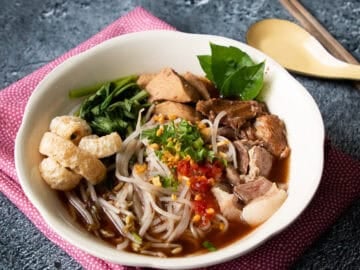
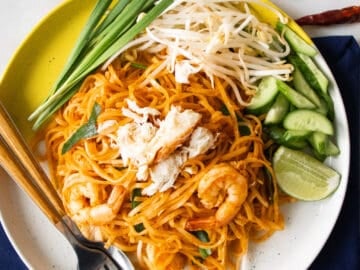

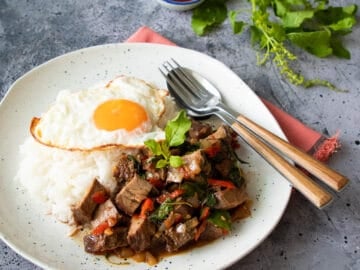
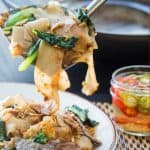
L.Reid says
DELICIOUS! The recipe and technique is flawless and you must do the vinegar, it is the perfect finish! I LOVE Hot Thai Kitchen, thank you for a wonderful meal!
PB Kelley says
Fantastic recipe. The work-arounds Pai provides are fantastic. We have substituted noodles and proteins and the recipe still turns out fantastic every time. The char and chew of the noodles makes the dish for me. Proteins are interchangeable as the noodles and sauce are the stars of the show.
Russ says
Awesome recipe, in my regular rotation. It's not something I typically order when I go out to a Thai restaurant but it's one of my favorites at home. Highly recommend! Haven't been able to track down fresh noodles yet (need to try her recipe for making those at home), but also great with store bought dry noodles.
Jen Walker says
Absolutely love this recipe! I’ve introduced my Son to my favorite Thai dish. Your cooking directions made this possible…
Karan says
Thank you so much for the tip on how to use dry rice noodles because I had dry rice flakes (think big and square), so after soaking I cut them in half and they were just fine. I had tried a similar recipe before and had awful trouble with the noodles, but following your directions I got a wonderful dinner of real Pad See Ew and my husband and I both agreed we could eat another serving each because it was so good.
Lisa says
“Fresh” means the ones that are already cooked in a package.
There’s a page on this website that specifies how to prepare the wide noodles by soaking, just FYI.
Kaj says
Thank you for this recipe, I’m looking forward to making it. I have a question, I am using tofu and have some black Chinese vinegar. Do you think I could add a small amount to the tofu for flavour and then add red chillies in at the end so I could skip the part with the chilli vinegar?
Pailin Chongchitnant says
You can just add chilies to the noodles, and use the vinegar as a condiment at the end. I wouldn't put the vinegar IN the noodles because it's meant to be added "to taste" as a condiment and it will be easy to overdo.
Thomas Wynn says
Thanks for this recipe!! Can you clarify, is the 6oz of protein and 4 to 6 stalks per serving or should they be split in 2 like the noodles?
Pailin Chongchitnant says
The protein doesn't need to be separated because you can cook it all at once, and you'll just add half back in for each batch. Everything else should be split.
Hannah says
Wow!!!! I am so grateful. this is restaurant quality! I cannot believe how amazing this turned out. I will say, I added a bit more brown sugar for my taste 1-2 tsp more. I plan to use less for my mom who likes it less sweet.
gergana shkodrova says
Thank you, thank you, this recipe is the best ever! It turned out great, even if I had to make do with what I have as supplies (problematic this corner of the earth) and utensils (likewise). Made me feel so nostalgic, too... Thailand, my love:))))
Brenbert says
i have spent 5 years trying to find the best pad see ew recipe.
this is the one.
i like using dried noodles and getting them al dente 🙌
Cindy says
I have a question. This was one of my favorite dishes for several years. Then suddenly the taste changed. Now the sauce tastes burnt to me. Is it supposed to taste that way? I've ordered it three times lately and it always tastes burnt and I don't care for that. I guess I need to try your recipe and see if I get the same result as the restaurant. I'd love to hear your feedback.
Paige says
Just my personal experience: Do other people note the same change in flavor? I just had a type of heath disorder that changes my taste (for now, I hope). Unwanted taste notes now can ruin my food, including burnt, mineral, and bitter. I'm sorry for your change in enjoyment.
Pailin Chongchitnant says
It can taste smokey, which might be what you're calling "burnt". But that depends on how it's made and homemade ones rarely has this smokiness. It happens when a restaurant uses a carbon steel wok over high heat. Just FYI that the smokiness is one of the traits of PSE that many people love and many cooks try to go for that. But I suppose it can be overdone, which might be your situation.
Teresa Williams says
The best Pad See Ew recipe ever! I’ve travelled to Thailand twice and adore the food. Your recipe’s are exactly what I’ve been looking forward to reproducing since my trips. Thank you so much for giving us REAL Thai recipes. ❤️
Nicole says
Any tips for working with fresh-frozen rice noodles? I stocked up on my last trip to the Asian market, then froze all the packages. But when I cooked them, they fell almost completely apart, even with very gentle handling. Does freezing them just destroy the noodles' texture and structural integrity? 😂 and if so, is there anything I can do with these besides composting? I hate to see these go to waste. TIA!
Pailin Chongchitnant says
Oh, I don't think they can be frozen at all as you have found out...unfortunately I think this is compost!
tc says
Thorn: first attempt - failure. Will check my sauces because there was a bitter, almost chemical undertone that’s not supposed to be there. Probably need to replace one.
Rose: this is one of my •favorite• meals and I know I’ll find what went wrong on my end, so failure is fleeting! Also, this dish is probably going to be my excuse for a larger carbon steel wok…
Love your videos! Can’t wait to make this dish a success in my home!
Erin says
I made this with some bean sprouts tossed in at the end for some added lightness and crunch. Highly recommend. Great recipe.
Randi Maves says
Made this last night. My first attempt at pad see ew which is my favorite Thai dish. It turned out excellent! The sauce was perfect. Will make again for sure.
Michael Vaewhongs says
This entree was my first Thai food home cook. It remains my most cooked one as it is my immediate family's and in-laws' favorite Thai food. I have made it at least 100 times in past four years. It is one entree I can cook from muscle memory.
Cooking for my native Thai and foodie parents, Pailin's recipe is spot on. It tastes just like great Bangkok street vendor's Guay Tiew Pad See Ew Her tips here (on other recipes) are golden nuggets. I agree, the most important tip/golden nugget is cook one portion at time. Stated another way: don't crowd the wok. This same tip applies to all other carbon steel wok cooking where wok hei is needed (e.g. Chinese fried rice).
Robin says
A tip for Londoners (or people willing to travel to London for truly fresh rice noodles).
Lo's Noodle Factory is the only place in London you can get freshly-made, unrefrigerated rice noodles. The noodles are still warm when they hand them over, and they're a game-changer for making dishes like pad see ew. They sell ho fun and cheung fun (plain and with shrimp/chive).
I know Pai suggests ho fun in this post, but I think that's because they're more likely to be available. If you want to get closer to "real Thai" pad see ew, you can buy the plain cheung fun at Lo's (be sure to ask for "plain", it's not the default), and then at home you can gently unroll them into flat sheets, and tear or slice into wide noodles.
Cooking them the same day is ideal, but if that's not possible then try to do the unrolling part as soon as you can - after that you can refrigerate or even freeze them, sliced or unsliced. Just make sure to keep the layers separated with plastic wrap or similar so they don't fuse together. Frozen noodles will thaw quickly, but they'll need a quick blast in the microwave with a splash of water to revive them before cooking.
Lo's is in an alley in Chinatown called Dansey Place, and it's just an unmarked open door leading into a short hallway with an A4 price list on the wall. I'll be honest, the first time I tracked it down I was too shy to walk in, but don't be scared! Just stick your head around the corner into the main shop/factory, and someone will be there to sort you out. Bring cash, they don't take cards. As of April 2023 it's £1.50 per 450g bag, and they will definitely prefer it if you can bring exact change 🙂
Gregg says
If making this vegetarian, should you do anything besides sub for vegetarian oyster and fish sauce? Are there any tips for getting the flavor right - i.e. using dehydrated mushrooms, etc in a curry?
Diana Boontriga Evans says
Delicious
Dela says
Hi Pai
I love your channel and all your content and have also bought your cookbook . I also live in Vancouver and I was wondering where you buy your thai supplies and sauces? I find that so hard especially for a non-thai person to know where to get these ingredients.
thank you so much again for any suggestions you have and also for all the great content you create to make us look good when we make Thai food at home:)
Pailin Chongchitnant says
Hi Dela, thanks so much for your kind words and for buying the book! If you check out the grocery map here https://hot-thai-kitchen.com/locate-a-thai-grocer/ you'll see a few. I go to 88 Supermarket, My Tho and New Fresh which have most things I need.
Jacob says
Hi - I made this and enjoyed it. Thank you. I have a question though....per serving is it 2 tbs of oyster sauce or would it only be 1 tbs for the serving if you cook the two servings separately.
Also, the video mentioned sugar but sugar is not in the recipe. Should there be sugar in this?
Thank you and have a great day - Jacob
Pailin Chongchitnant says
Hi Jacob, the amount of ingredients provided always matches the number of servings stated at the top of the recipe. So the 2 Tbsp of oyster sauce is for 2 servings, so each serving would have only 1 if cooked separately. Also, the sugar is listed in the ingredient list, but not in the sauce section because sugar doesn't dissolve well in the thick sauce so I like to add it separately.
Ju says
I decided to add the sugar into the sauce (to avoid missing them out when cooking), and it worked!! 😀 😀 😀
I also PRE-COAT all the hor-fun with all the sauce, then only divide them to 3 portions (I'm making 3 portions for lunch today).
That prevent breaking the hor-fun and make cooking this dish even easier!!!! 🥰🥰🥰
Scott Schmidt says
Folks, Nona Lim's computer system finally advised me that her wide rice noodles were again in stock, so I ordered an 8-pack. These are available online, but are often out of stock. Last night, after months of waiting, I was able to cook up some Pad Se Ewe following this recipe (you can get the Golden Mountain Sauce on Amazon). I've got to tell you that the dish, made using these noodles and this recipe, is indistinguishable from the best PSE I've ever had at good Thai restaurants. There's no Thai food anywhere near where I live so I decided to do it myself, and the combination of Nona Lim noodles and this recipe made it possible. Now, please excuse me, but I've got to go make another batch because just writing about it makes me crave it all over again.
Ken says
Hi, I live in Oakland discovered Nona Lim’s noodles and other items a year or so ago. My wife is Thai and was struggling to get Pad See Ew to come out right and then I (yea, somehow) found a good recipe online and made it with Nona’s noodles and we were both amazed. I recently got a bunch of Laksa and pad see ew noodles from her but the pad see ew have not been as easy as in the past to work with. Do you microwave in the pouch first or handle them differently? By the way I had seen some other videos of yours a while back but I was checking some more on YouTube of Pad See Ew to get additional ideas and came upon your version, which definitely has some nice little additions.
Scott Schmidt says
For the PSE wide noodles, I thaw them in the fridge, then snip open the pouch a little and microwave them. Once they're good a d hot, I add them to the wok to make the dish. Works great every time.
Ken says
I think that's the mistake I made...I found the Laksa noodles didn't need that so was trying to do the same with the Pad See Ew noodles...I'll go back to the microwave directions. Thanks!
Todd Thoresen says
Not surprisingly, excellent. I have always been steered well with Pailin's well thought out recipes, and great videos. I will never hesitate to try any of her dishes and not expect great results. I love that she calls out brands!
L says
This recipe is so simple, quick, and easy! For those who are having trouble finding the noodles, if you can find fresh "rice paper" at a Korean market, it's the same thing except you'll have to slice it into noodles yourself. I used a Chinese light soy sauce where it calls for soy sauce except when it calls for dark soy sauce.
Beth says
This looks amazing! I can’t wait to try making it. Can you please tell me what wok you are using and can I get that in Canada?
Adam from HTK says
Hi! She uses a Joyce Chen similar to this one here https://kit.co/hotthaikitchen/kitchen-tools-i-use/3935400-joyce-chen-classic-s Cheers! Adam
Victoria says
I’d give this 6 stars if I could, very tasty and super easy. Taste better than most take away Pad See Ew I have tried and also after trying a lot of recipes online, I find this one the best and authentic. Love it with tons of white pepper. Thank you so much for sharing this!!!
Adam from HTK says
Thanks Victoria! 🙂
Chris says
Came out awesome....I watched the video after unfortunately. I purchased rolled noodle's but still came out great, but I know now where to look for the flat noodles!
Loved it!
Adam from HTK says
lol re the noodles ... and would still make a very interesting dish! 🙂 Thanks!
Michaël says
This recipe is perfect: well written, easy to follow. My pad see ew now tastes just like at my favorite Thai take out!
Adam from HTK says
Thanks Michaël!
Mark says
My wife is Lao, and obviously there are many crossover dishes between Lao and Thai food. She loves Pad See Ew. She was SO happy with my first shot at this recipe, that she now requests that I make it for her. Our 5-year old just had it for the first time, and aside from the "green stuff" she loved it too. Ha ha! Looks like Pad See Ew will become one of my regular dishes around here. Thanks for the recipe!
Quick question. The recipe recommends fresh noodles; store-bought, or make my own. But sometimes these options wouldn't work on short notice. Are there any brands of dried wide rice noodles that you might be able to recommend?
Melody says
I live in a very asian area and even I had a hard time finding the large sheets of ho fun style noodles. I went to 3 different grocery stores and never once saw dried broad-enough noodles. Maybe the closest thing would be thick cut phó noodles that readily come dried in bags. But those may break apart to easily during the stir fry and be a weird way to eat little noodle crumbs.
I didn't find ho fun style sheet noodles but instead found fresh phó ap cháo noodles (pre cut in ribbons, could have been thicker ribbons, oh well) or banh cuon sheets work too. I did separate the noodles before putting in freezer for super quick hardening so they would stir-fry well. I don't recommend the pre-rolled phó noodles because the rolled up-ness doesn't absorb sauce well.
Owie says
Hi! What's a good substitute for the Chinese Broccoli?
D says
Regular broccoli will work as well!
Jon says
I used broccolini and it turned out great!
Jesi says
I made this with your recipe for rice noodles and loved it! There was an amazing Thai restaurant where I used to live and I finally found a recipe that was on par and better than anywhere nearby me now. I used broccolini and shrimp. Thank you for the great recipes!
Greg says
Awesome recipe, but can you clarify something for me? For the soy sauce, should we use regular or Thai soy sauce?
Keep up the great work!
Jarvey says
You are the best!!
I was surprised how it good it turned out for me on the first try. Very tasty!!
Liza says
Unbelievably good! Restaurant quality dish!! Awesome!!
Ian says
I started cooking Thai food at home because I wanted to know how to make this dish. Noodles can be hard to find, but she has a recipe for making your own and an egg noodle version. Pretty simple recipe yet always tasty.
Daniel says
I make this so often that I want to make a large quantity of the sauce to keep around. Are there any drawbacks to doing this? Would the various sauces interact at all?
Tony says
I made about a pint of the sauce and have kept it on the counter in a sealed glass jar for over a month. A quick shake and it's ready to go. I used Healthy Boy Sweet Soy Sauce for the dark, so adding sugar to the fry isn't necessary. I use it regularly in a quick breakfast stir fry of Chinese "instant" wheat noodles (Dayat brand), egg, and Chinese broccoli. The perfect way to start a day.
Michael says
The famous super easys stir fry dish for your home.
Very fast to make.
That's the real taste of Thailand.
Gary Poole says
This is one of my favourite foods,I often buy it in Thailand where its quick,filling and delicious.Ive tried making it myself many times and can buy all the ingredients locally including the wide fresh rice noodles.Ive never managed to stop the noodles from breaking up into small pieces.I think the tip is to cook separately with the sauces,and turning once or twice so they hold together.
Stephen Chan says
One of my weeknight dinner top picks, as this is fast yet delicious!
Kaylee says
I've been trying to make thai for years and it never tastes quite like how I want it to......until now 🤩 5 ⭐ isn't enough!